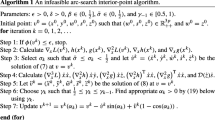Abstract
In this paper, we propose an arc-search infeasible-interior-point method for linear programming. The proposed algorithm is based on a wide neighborhood of the central path and searches the optimizers along the ellipses that approximate the entire the central path. We also establish polynomial complexity of the proposed algorithm. Finally, numerical experiments show that the proposed algorithm is efficient and reliable.
Similar content being viewed by others
References
Ai, W.: Neighborhood-following algorithms for linear programming. Sci. China Ser. A 47, 812–820 (2004)
Ai, W., Zhang, S.: An \(O(\sqrt{n}L)\) iteration primal-dual path-following method, based on wide neighborhoods and large updates, for monotone LCP. SIAM J. Optim. 16, 400–417 (2005)
Anstreicher, K., Bosch, R.: A new infinity-norm path following algorithm for linear programming. SIAM J. Optim. 5, 236–246 (1995)
Browne, S., Dongarra, J., Grosse, E., Rowan, T.: The netlib mathematical software repository. Corporation for National Research Initiatives (1995)
Hung, P., Ye, Y.: An asymptotical \(O(\sqrt{n}L)\)-iteration path-following linear programming algorithm that use wide neighborhoods. SIAM J. Optim. 6, 570–586 (1996)
Jansen, B., Roos, C., Terlaky, T.: Improved complexity using higher-order correctors for primal-dual Dikin affine scaling. Math. Program. 76, 117–130 (1996)
Karmarkar, N.: A new polynomial-time algorithm for linear programming. Combinatorica 4, 373–393 (1984)
Lustig, I.J.: Feasible issues in a primal-dual interior-point method. Math. Program. 67, 145–162 (1990)
Lustig, I.J., Marsten, R.E., Shanno, D.F.: On implementing Mehrotra’s predictor-corrector interior-point method for linear programming. SIAM J. Optim. 2, 435–449 (1992)
Mizuno, S.: Polynomiality of infeasible-interior-point algorithms for linear programming. Math. Program. 67, 109–119 (1994)
Mizuno, S., Todd, M.J., Ye, Y.: On adaptive-step primal-dual interior-point algorithms for linear programming. Math. Oper. Res. 18, 964–981 (1993)
Mehrotra, S.: On the implementation of a primal-dual interior point method. SIAM J. Optim. 2, 575–601 (1992)
Monteiro, R.D., Adler, I., Resende, M.G.: A polynomial-time primal-dual affine scaling algorithm for linear and convex quadratic programming and its power series extension. Math. Oper. Res. 15, 191–214 (1990)
Nesterov, Y.: Long-step strategies in interior-point primal-dual methods. Math. Program. 76, 47–94 (1996)
Potra, F.: An infeasible-interior-point predictor-corrector algorithm for linear programming. SIAM J. Optim. 6, 19–32 (1996)
Roos, C., Terlarky, T., Vial, J.P.: Theory and algorithms for linear optimization: an interior-point approach. Springer, New York (2006)
Tanabe, K.: Centered newton method for linear programming: interior and ‘exterior’ point method. New Methods Linear Program. 3, 98–100 (1990). (in janpanese)
Tian, D.G.: An entire space polynomial-time algorithm for linear programming. J. Glob. Optim. 58, 109–135 (2014)
Tian, D.G.: An exterior point polynomial-time algorithm for convex quadratic programming. Comput. Optim. Appl., 1–28 (2014)
Wright, S.J.: Primal-Dual Interior-Point Methods. SIAM Publications, Philsdephia (1997)
Yang, Y.: Arc-search path-following interior-point algorithms for linear programming. Optim. Online (2009)
Yang, Y.: A polynomial arc-search interior-point algorithm for convex quadratic programming. Eur. J. Oper. Res. 215, 25–38 (2011)
Yang, Y.: A polynomial arc-search interior-point algorithm for linear programming. J. Optim. Theory Appl. 158, 859–873 (2013)
Yang, Y.: Arc-Search Infeasible Interior-Point Algorithm for Linear Programming. arXiv preprint arXiv:1406.4539 (2014)
Zhang, Y., Zhang, D.: On polynomiality of the Mehrotra-type predictor-corrector interior-point algorithms. Math. Program. 68, 303–318 (1995)
Zhang, Y.: On the convergence of a class of infeasible interior-point methods for the horizontal linear complementarity problem. SIAM J. Optim. 4, 208–227 (1994)
Author information
Authors and Affiliations
Corresponding author
Rights and permissions
About this article
Cite this article
Yang, X., Zhang, Y. & Liu, H. A wide neighborhood infeasible-interior-point method with arc-search for linear programming. J. Appl. Math. Comput. 51, 209–225 (2016). https://doi.org/10.1007/s12190-015-0900-z
Received:
Published:
Issue Date:
DOI: https://doi.org/10.1007/s12190-015-0900-z




